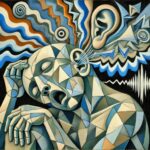
Mysterious Ménière’s Inner Ear Condition
April 11, 2025
Hearing Loss and Falls: Why Wearing Hearing Aids Could Save More Than Just Your Hearing
April 14, 2025Hearing impairment has been a challenge throughout human history, prompting continuous efforts to develop methods for enhancing auditory perception. From rudimentary acoustic devices to early electronic amplification, the history of hearing aids and hearing diagnostics reflects both scientific innovation and the evolving understanding of auditory health. This document explores the development of hearing aids and hearing diagnostics from their earliest forms to the sophisticated technologies available by the 1930s.
Early Hearing Assistance: Pre-19th Century
Hearing Loss in Antiquity
Records of hearing impairment date back to ancient civilizations. The Ebers Papyrus, an Egyptian medical text from around 1550 BCE, includes references to hearing loss. However, hearing impairment was often misunderstood, and in many ancient cultures, those with significant hearing loss were marginalized. In ancient Greece, Aristotle erroneously believed that deaf individuals were incapable of rational thought due to their inability to hear spoken language.
Hand Cupping and Natural Acoustic Enhancement
One of the simplest and earliest hearing aid techniques involved cupping the hand behind the ear to collect and direct sound waves toward the ear canal. This method provided a small but noticeable amplification effect. This natural approach to sound enhancement likely predates any physical devices designed for hearing assistance.
The Advent of Mechanical Hearing Aids: The Era of Ear Trumpets (17th – 19th Century)
Early Acoustic Devices
Before electricity, hearing assistance relied on mechanical devices that funnelled and directed sound waves. The most common of these were ear trumpets, which appeared in various forms from the 17th century onward.
- Jean Leurechon (1634): A French priest and mathematician, Leurechon, is credited with one of the earliest references to an ear trumpet. His descriptions of conical and curved devices suggest the growing interest in mechanical hearing assistance.
- Frederick C. Rein (1800s): By the early 19th century, the first commercial production of ear trumpets began. Frederick C. Rein, a London-based manufacturer, developed a variety of ear trumpets, including collapsible and portable designs.
Types of Ear Trumpets
Ear trumpets varied in design, catering to different levels of hearing loss:
- Simple Trumpets – Basic conical tubes that amplified sound.
- Speaking Tubes – A flexible tube that allowed a speaker to speak directly into one end, directing the sound into the user’s ear.
- Collapsible Ear Trumpets – Foldable versions for easier transport.
- Ornate and Hidden Hearing Devices – Disguised designs for social acceptability, such as hearing aids built into canes, fans, and even clothing.
Limitations of Ear Trumpets
While ear trumpets provided some level of amplification, they had significant drawbacks:
- Distortion of sound quality
- Limited frequency response (primarily low frequencies were amplified)
- Bulky and socially conspicuous
Despite these limitations, ear trumpets remained the primary hearing assistance device for over two centuries, up until the advent of electrical amplification in the late 19th century.
Early Hearing Diagnostics: The Birth of Audiology
Basic Hearing Tests Before the 19th Century
Prior to the scientific study of hearing, assessing hearing loss was rudimentary and subjective. Physicians and healers would:
- Speak at different volumes and distances to gauge hearing ability.
- Use environmental sounds (such as clapping or the ticking of a watch) to measure hearing sensitivity.
The Role of Tuning Forks in Hearing Assessment (1820s Onward)
In the early 19th century, tuning forks became essential diagnostic tools in audiology. The most notable tests included:
The Weber Test (1834)
Developed by German physician Ernst Heinrich Weber, this test involves placing a vibrating tuning fork on the forehead or top of the head to determine if sound is heard equally in both ears. It helps differentiate between conductive hearing loss (caused by issues in the outer or middle ear) and sensorineural hearing loss (resulting from inner ear or auditory nerve damage).
The Rinne Test (1855)
Introduced by Heinrich Adolf Rinne, this test compares air conduction (hearing through the ear canal) and bone conduction (hearing through vibrations in the skull). A tuning fork is placed against the mastoid bone behind the ear and then near the ear canal. If air conduction is better, hearing is likely normal or sensorineural. If bone conduction is better, conductive hearing loss is suspected.
These tests marked a significant step forward in the scientific evaluation of hearing impairment and remained widely used for decades.
The Electrical Revolution: Carbon Microphone Hearing Aids (1898 – 1920s)
The introduction of electricity in the late 19th century transformed hearing aid technology.
The First Electric Hearing Aid: The Akouphone (1898)
American inventor Miller Reese Hutchison developed the first electric hearing aid in 1898. Called the Akouphone, it used a carbon microphone to amplify sound.
How It Worked:
- A carbon microphone converted sound into an electrical signal.
- A battery-powered amplifier increased the strength of the signal.
- A receiver converted the signal back into sound.
Although the Akouphone was a major breakthrough, it had drawbacks:
- Large and cumbersome (required a tabletop setup).
- Poor sound quality (carbon microphones introduced distortion).
- Limited frequency response (amplification was inconsistent).
Despite these limitations, carbon microphone hearing aids became the standard technology for nearly two decades.
The Rise of Vacuum Tube Hearing Aids (1920s – 1930s)
The Invention of the Vacuum Tube
The invention of the vacuum tube in the early 20th century revolutionized amplification. By the 1920s, companies such as Siemens and Western Electric began producing vacuum tube hearing aids.
Advantages of Vacuum Tube Hearing Aids
- Greater amplification (suitable for severe hearing loss).
- Clearer sound with less distortion compared to carbon hearing aids.
- More precise volume control for users.
Limitations
- Large and cumbersome (early versions were worn as a pack).
- High battery consumption required frequent replacements.
- Expensive and not widely accessible.
By the 1930s, hearing aid manufacturers were working to miniaturise vacuum tube technology, setting the stage for further advancements in the coming decades.
The Birth of Audiometry: Scientific Hearing Measurement (1920s – 1930s)
The First Audiometer (1922)
The Western Electric 1-A Audiometer, developed by Harvey Fletcher, was the first instrument designed to measure hearing thresholds accurately.
- Allowed for standardised hearing tests.
- Helped diagnose specific frequency hearing loss.
- Provided data for early hearing aid customisation.
Impact on Audiology
The development of audiometry transformed hearing diagnostics from subjective assessments to quantitative measurement, leading to modern audiograms used today.
References
Bentler, R.; Duve, Monica R. (2000). Comparison of Hearing Aids Over the 20th Century. Ear and Hearing 21(6):p 625-639.
Bentler, R., Kenefick, J. (2009). Hearing Aid Innovation: 100+ years later. The Volta Review, 109 (1), 33-42
Curran JR, Galster JA. (2013). The Master Hearing Aid. Trends in Amplification. 17(2):108-134. doi:10.1177/1084713813486851
Francis, L., Weille, M.D., Bruce, H. Billings, B.A. (1937). A Study of the Efficiency of Carbon Microphone Hearing Aids. N Engl J Med;216:790-794. DOI: 10.1056/NEJM193705062161804
Hayden, AA. (1940). HEARING AIDS—TUBE OR CARBON? JAMA.;115(3):191–193. doi:10.1001/jama.1940.02810290021005
Kelly EA, Li B, Adams ME. (2018). Diagnostic Accuracy of Tuning Fork Tests for Hearing Loss: A Systematic Review. Otolaryngology–Head and Neck Surgery. 159(2):220-230. doi:10.1177/0194599818770405
Mudry A, Dodelé L. (2000). History of the technological development of air conduction hearing aids. The Journal of Laryngology & Otology. 114(6):418-423. doi:10.1258/0022215001905977
Valentinuzzi, M., (2020). “Hearing Aid History: From Ear Trumpets to Digital Technology,” in IEEE Pulse, vol. 11, no. 5, pp. 33-36, doi: 10.1109/MPULS.2020.3023833.


